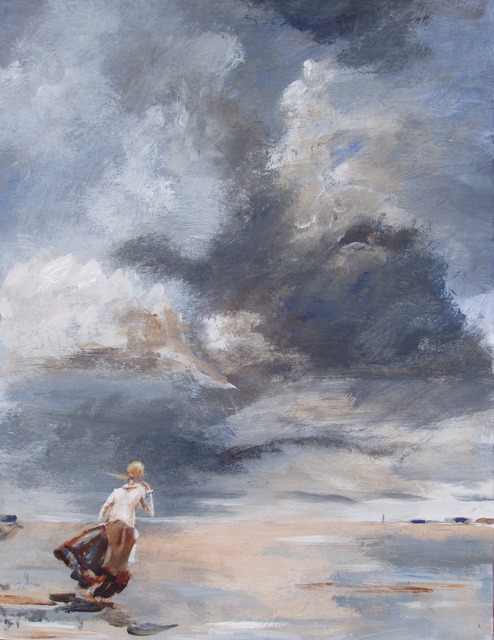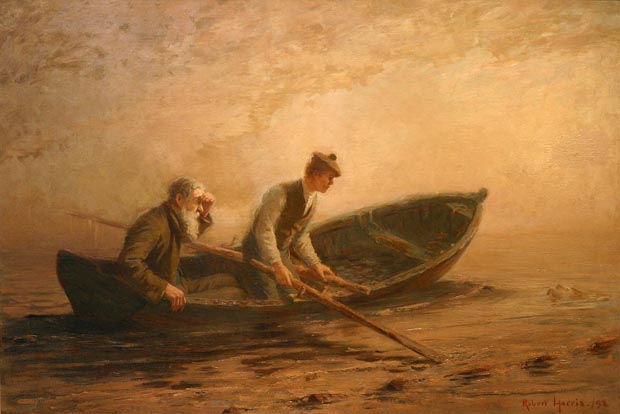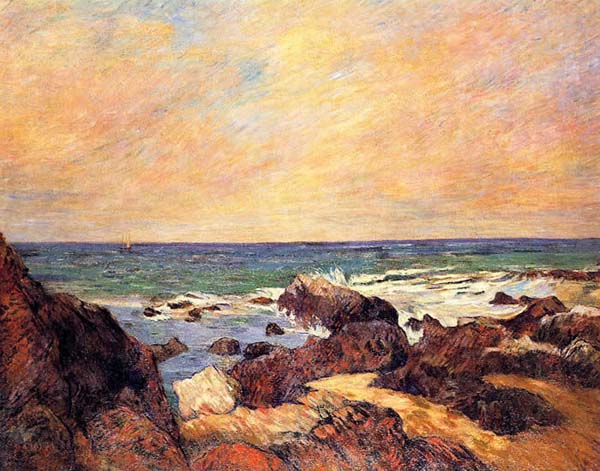The Sands of Dee
‘O Mary, fo and call the cattle home,
And call the cattle home,
And call the cattle home,
Across the sands of Dee.’
The western wind was wild and dark with foam,
And all alone went she.
The western tide crept up along the sand,
And o’er and o’er the sand,
And round and round the sand,
As far as eye could see.
The rolling mist come down and hid the land:
And never home came she.
‘O is it weed, or fish, or floating hair—
A tress of golden hair,
A drownèd maiden’s hair,
Above the nets at sea?’
Was never salmon yet that shone so fair
Among the stakes of Dee.
They row’d her in across the rolling foam,
The cruel crawling foam,
The cruel hungry foam,
To her gave beside the sea.
But still the boatmen hear her call the cattle home,
Across the sands of Dee.
By: Charles Kingsley

Synopsis:
Mary is suppose to call the cattle home, but accidentally drowns in the Dee. The boatmen can still hear her ghost calling for her cattle.
Major Themes and Motifs:
- Agriculture
- Natural Landscape
- Mythology
- Horror
Literary Terms Applicable to “The Sands of Dee”:
- Alliteration
- Ambiguity
- Auditory Imagery
- Caesura
- Character
- Characterisation
- Connotation
- Denotation
- Diction
- Figurative Language
- Foreshadowing
- Imagery
- Literal Language
- Metaphor
- Meter
- Mood
- Motif
- Personification
- Register
- Repetition
- Rhyme
- Rhythm
- Sestain
- Setting
- Simile
- Stanza
- Structure
- Symbol
- Symbolism
- Syntax
- Theme
- Tone
- Verbal Imagery
- Visual Imagery
Characters:
(in order of appearance)
Mary-
The protagonist, who is suppose to call the cattle home. One night, she drowns in the river Dee because of a nasty storm. After some time, she washes up on the shore. The Boatmen can still hear her calling her cattle home.
The Dee-
A personified river that accidently kills Mary after a storm. People fish in the river and catch salmon. The Dee is described as being cruel and hungry.
Boatmen-
They hear Mary’s spirit calling her cattle home.
The Speaker-
An unknown speaker, who recounts Mary’s tale. He speaks in a repetitive voice, and heavily personifies the river Dee.

Detailed Description of the Events within the Poem:
- Mary calls the cattle home across the sand of the river Dee.
- After a nasty storm, the river rises and presumably bursts its banks.
- Mary gets swept away and drowns.
- Her body floats in the river before it is washed up on shore.
- Even now, the boatmen, who fish at the river Dee, can hear Mary calling her cattle.
Significance of the Text:
This poem is a classic example of personification. Personification is, “the attribution of a personal nature or human characteristics to something non-human, or the representation of an abstract quality in human form.” The Dee is treated like a character in this poem, as he crawls up the sides of his banks and eats Mary.
Interesting Tidbit:
Charles Kingsley is a friend of Charles Darwin, and was sympathetic to the idea of evolution. He had received an advanced copy of the book, “On the Origin of Species.” An edited version of his feedback was included in an edition.
Where More of Charles Kingsley’s Work can be Found:
https://www.amazon.co.uk/Charles-Kingsley/e/B001ITRJTM
Words: 500

This poem concerns an event related to the River Dee (Afon Dyfrdwy) estuary between Wirral and Clywd. The painting shewn at the top of the page is not appropriate because the Wirral shoreline is most lacking in rocks, being sand and river sediment. In the poem, it is NOT the River Dee which is personified because the River Dee does not eat Mary. Downstream from Connah’s Quay The River Dee opens out to a wide expanse of a tidal basin, following a course somewhat west of center. Mary probably lived close to the river on the eastern side in either Burton, or more probably Neston, or Parkgate, which border the sand and mud flats which are only submerged during Spring Tides. What kills Mary is the very fast incoming tide from the Irish Sea when she strays after losing sight of the shoreline due to mist and fog descending as the daylight ends. The incoming tide is very fast because the river estuary is so flat, which is also why the unattended cattle were safe grazing on any vegetation during the day, well away from the center course of the river. What the poem never addresses is that as Mary failed to bring the cattle home, what happened to the cattle, and was it not just a tragic loss of life losing a child, but, if the cattle did not return safely of their own accord, but also an economic disaster for the family. Atlantic salmon (as well as sea trout) are still to be found in the River Dee according to the season of the year.
LikeLike
Many years ago when I was doing “standard 4” we were made to memorise “The sands of Dee”. It, the poem, didn’t make any sense to me then, obviously me being an African child. It did however, trigger within me some sad emotions that I couldn’t explain.
Reading the poem now makes me appreciate those years when I was still “small and christmas trees were tall”(Bee Gees)
LikeLike
Very bad
LikeLike
i become pro
LikeLike